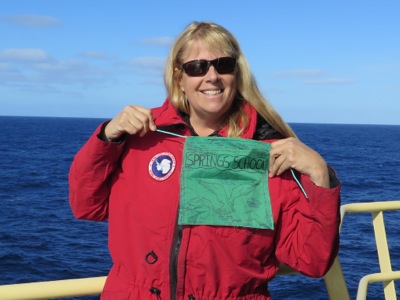I miss google
I am an addict without her fix, I can not tell you how much I miss google. Almost every bit of scientific data I share with you takes me hours to decode. Yes, I have a forestry degree, and yes I teach science, but this level of geology and technology is way out of my league. Do you know how embarrassing it is to constantly ask questions over and over? I am so lucky that this science party is tolerant and understanding as I grapple with concepts that are truly basic.
Last night the magnetometer was deployed. I will of course include pictures but you must understand up until yesterday afternoon I had no idea that the earth's magnetic field switched from normal to reversed polarity in various periods of time from tens of thousands of years to 40 million years. Did you know?
 Rain, cold wind and four meter seas make for a great magnetometer launch!
Rain, cold wind and four meter seas make for a great magnetometer launch!
So this morning, before everyone else was up I was fortunate to get some one on one tutoring from Bud Davis, a Phd student to help me understand the complexities of why we are towing a magnetometer. In a word fascinating.
 Working with Bud to understand the purpose for a magnetometer in determining successive undersea lava flows covering many millions of years.
Working with Bud to understand the purpose for a magnetometer in determining successive undersea lava flows covering many millions of years.
What is even more fascinating is that the study of ocean floor spreading could be related to Arizona and all our lava. If we had a field that had successive volcanic flows over long periods of time we could use a magnetometer and check polarity. I will have to ask some geologists I know if this is done in Arizona.
I also spent some time today with the mammal observers. The two ladies on this voyage work for a company that was hired by the government of South Georgia and asked to complete an incidental harassment assessment. In layman's terms to document marine mammal sightings, record data and possibly ask for the cessation of the seismic if marine mammals are within 100 meters of the source (us). And in our case that source is the seismic acquisition process which will be collecting sea floor data. The equipment will be deployed off the back deck of the vessel.
 Meet Lexi and Nina the protected species observers.
Meet Lexi and Nina the protected species observers.
As part of the social calendar on board The Palmer each day we have been privileged to have a talk from our resident experts. Today's talk was on the South Georgia and Southern Ocean Ecosystems by Graham Parker a conservation biologist out of New Zealand who specializes in Southern Ocean Ecology. From the four meter wingspan of a great albatross to the southern elephant seal taking a 1300 meter dive the presentation was fabulous and I look forward to hopefully seeing some of these species once we arrive at South Georgia.
 Graham Parker giving a talk on the different species we might find in the environment surrounding South Georgia.
Graham Parker giving a talk on the different species we might find in the environment surrounding South Georgia.
It is a simply glorious day today, calm seas, the sun is out and lots of people are taking advantage of the amazing weather with walks on the deck. I wish to take a moment to hi-light Springs School from East Hampton, New York. The students at Springs School and their teacher Mrs. Seff have been doing an excellent job of following along on our expedition and asking some spot on questions. Thank you Springs School!
 A huge should out to The Springs School in NY. Great job with the students following the blog and asking questions!
A huge should out to The Springs School in NY. Great job with the students following the blog and asking questions!
Another huge shout out to Peace Surplus in Flagstaff, Arizona. Thanks to Peace I have these amazing polarized sunglasses so that I can fully appreciate the brightness of the day. And we will end out day on the helo-deck, where there are great zodiac's. It is these mini-vessels that will be ferrying people to South Georgia for the GPS portion of our scientific expedition.
 From Wisconsin to Kansas there are some great people following our expedition to the Southern Ocean.
From Wisconsin to Kansas there are some great people following our expedition to the Southern Ocean.
Thanks go out to the Aldo Leopold Nature Center in Wisconsin for the great series of flags and then down to Jackson Heights Middle/High School in Wisconsin for making our exploration of the zodiac so much more fun! See everyone tomorrow.


Comments